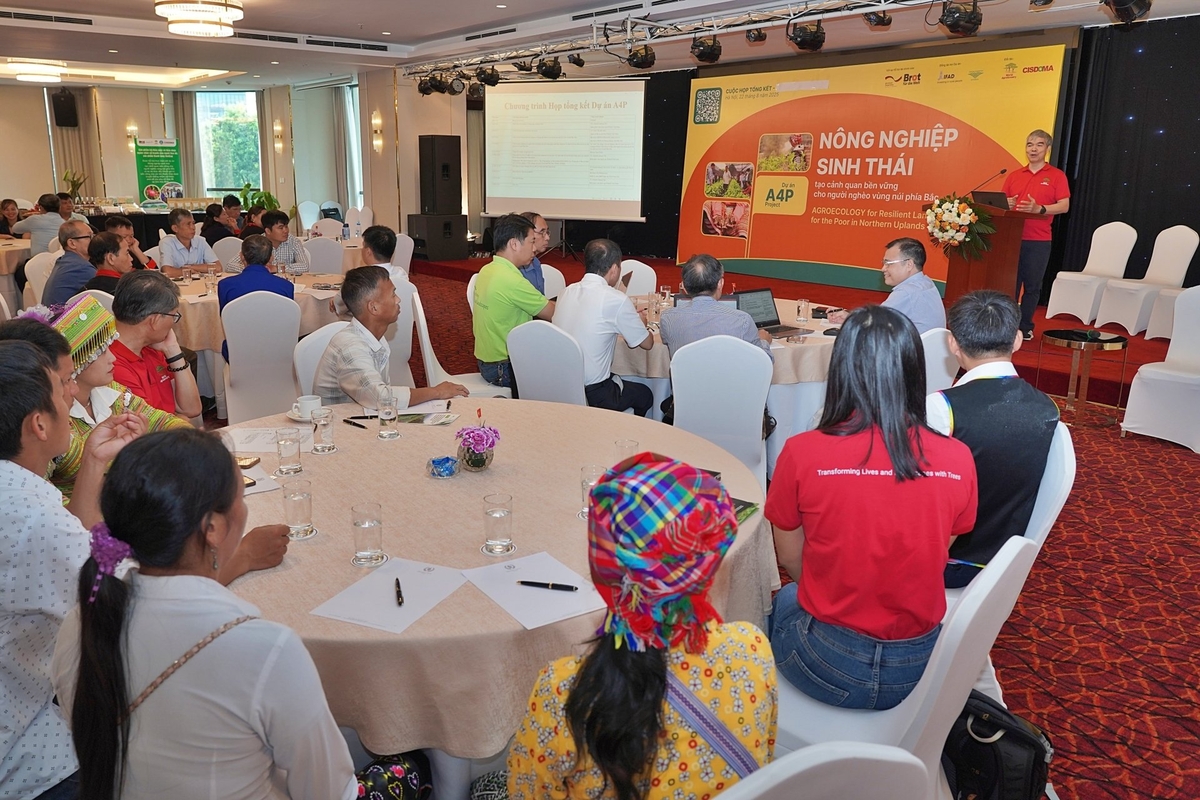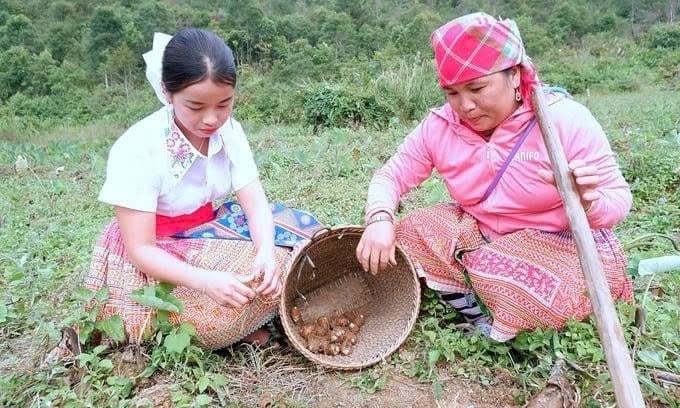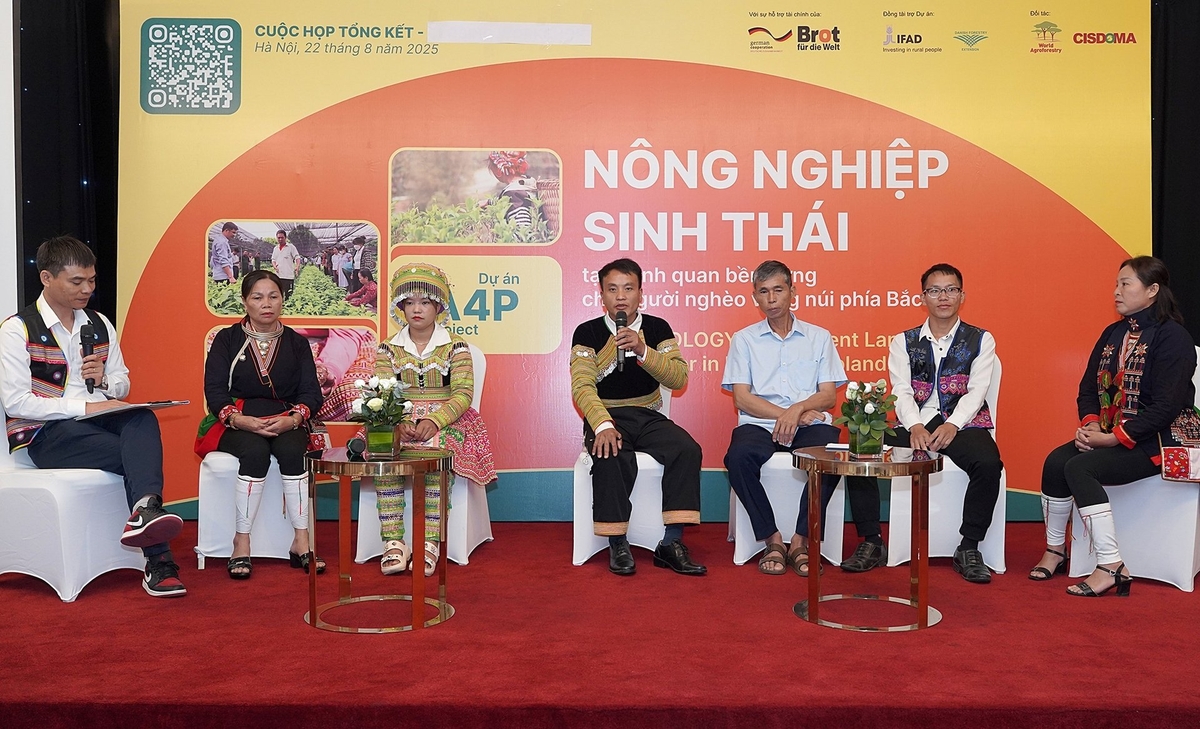December 27, 2025 | 01:47 GMT +7
December 27, 2025 | 01:47 GMT +7
Hotline: 0913.378.918
December 27, 2025 | 01:47 GMT +7
Hotline: 0913.378.918
The "Agroecology for Resilient Landscapes for the Poor in Northern Vietnam" (A4P) initiative ended with a closing workshop at the World Agroforestry (ICRAF) Vietnam office on August 22.
During the four-year period preceding the administrative restructuring of Yen Bai and Hoa Binh provinces, the A4P project restored hundreds of hectares of land, revived thousands of native trees, rescued local crop varieties from decline, and produced policy recommendations that are currently being circulated at the national level.
The International Fund for Agricultural Development (IFAD), the Danish Forestry Extension, and Germany's Federal Ministry for Economic Cooperation and Development (BMZ) provided funding for the project. ICRAF worked with Vietnamese agencies to connect international resources with local requirements, coordinating the program.
In the Tram Tau district of Yen Bai, 128 households engaged in agroforestry models on a 50-hectare area, sowing 15,426 trees and five tons of forage grass. Peaches, plums, persimmons, guava, lemon, michelia, pomu pine, and Shan tea comprised the crops.

Dr. Nguyen Quang Tan, National Coordinator of ICRAF in Vietnam. Photo: Bao Thang.
In Kim Boi, Hoa Binh, 90 households planted 14,401 trees on 50 hectares. These trees included canarium, michelia, bamboo, longan, pomelo, lychee, and mango, which are either native or economically valuable and well-suited to the local environment.
After 18 months, Tram Tau's mixed fruit trees had an average height of 136.5 cm and a canopy diameter of 115.2 cm, which greatly exceeded the performance of previous models. The average height of mixed orchards with timber and short-cycle crops was 152.9 cm, and the basal diameter was 2.3 cm. Improvements in soil quality and ecological cover were evident in the findings.
A significant development was the substantial decrease in the use of chemical fertilizers. At Tram Tau, three-to-five-year-old Tam Hoa plum trees required only 0.14 kg nitrogen, 0.09 kg phosphorus, and 0.12 kg potassium per tree, cuts of 60%, 70%, and 64% respectively compared with sector guidelines. Instead, farmers applied 10 kg of decomposed manure per tree.
A trial in Khau Ly village on 1,000 square meters of vegetables using reduced chemical fertilizer plus organic matter produced 15.7 tons of cai meo (a local leafy green) per hectare. Soil pH rose from 6.0 to 7.7, with marked improvements in organic matter and nutrients, considered vital scientific evidence for the long-term benefits of agroecology.
Additionally, the initiative prioritized preserving indigenous species. Over the course of two generations, the upland taro, which is essential to the H'Mong way of life in Tram Tau, was rehabilitated, resulting in an increase in plant height, leaf length and breadth, and sheath length, evidence of genetic recovery.

Hundreds of delegates attended in person in Hanoi on the morning of August 22. Photo: Bao Thang.
Shan Tuyet's tea value chain in Suoi Giang provided farmers with access to the 2024 tea festival, processing and e-commerce training, and an expanded market entry. In order to enhance the resilience of livelihoods and diversify income streams, Kim Boi's work concentrated on medicinal herbs and dragon fruit, in addition to business skills training, nurseries for botanical plants, and market connections.
A4P had an impact on policy in addition to providing direct benefits to producers. The project experience was incorporated into Vietnam's extension system through the development of draft recommendations at the provincial and national levels. Scaling up ecological practices necessitates a "farmer-to-farmer" learning approach.
It was not solely the technical results of the project that were significant; it also demonstrated Vietnam's capacity to connect international resources with domestic challenges. As a consequence of the A4P results, global agroecology networks are now sharing them, which is aiding in the transformation of food systems on a global scale.

Members of Ban Mu Agricultural and Tourism Cooperative harvest upland taro. Photo: Bao Thang.
Despite obstacles including the Covid-19 pandemic, land shortages, and labor constraints, the project achieved core goals: raising poor households’ income, reducing chemical use, conserving native species, and opening new policy space. It demonstrated how fragile, erosion-prone slopes can be transformed into sustainable agroecological landscapes that simultaneously improve livelihoods and mitigate climate change.
At the closing workshop, experts agreed that agroecology is not only a timely solution for Vietnam’s northern mountains but also a key to global food system transformation.
In a message to the workshop, Dr. Matthias Geck, the coordinator of the Agroecology Transition Partnership Forum at CIFOR-ICRAF Nairobi and an expert in agroecology systems, stated, "Agroecology is the future, not the past. It builds on indigenous knowledge combined with modern methods, creating production systems that respect people, protect the planet, and can feed the world without destroying the environment.”
According to him, Vietnam’s A4P trials provide crucial real-world evidence to drive this transition. Dr. Nguyen Quang Tan, the country coordinator of ICRAF Vietnam, underscored that A4P's objectives exceeded mere assistance to farmers; rather, they included the development of a methodology for the transition from conventional to agroecological farming. "We aspire to make a tangible contribution to the implementation of Vietnam's National Action Plan for the transformation of the food system to be transparent, responsible, and sustainable by 2030 by applying the lessons we have acquired," he stated.
The project's value is most evident in the producers' experiences, rather than in the data and reports.
According to Giang A Vau, director of Ban Mu Agricultural and Tourism Cooperative in Lao Cai, the agroforestry model has altered the way farmers cultivate steep fields. "In the past, individuals cultivated only one crop, which frequently failed due to inclement weather." Currently, we are able to maintain the integrity of the soil and generate additional income by combining Shan tea, timber, and produce. He stated that the rainfall no longer wash away everything.

Farmers who directly benefited from the A4P Project shared at the closing ceremony. Photo: Bao Thang.
Elder farmer Quach Dinh Thao described it in generational terms: “I found it strange at first to plant so many kinds of trees together. But after a few years, they all grew, the soil stayed moist, and what our ancestors never imagined has now become reality thanks to the project".
A4P has demonstrated that new methods can assist ethnic minority communities in enhancing their livelihoods, and that Vietnam is prepared to serve as a global leader in the transition to green agriculture.
The northern mountains now serve as real evidence of the viability of agroecology, from the reduction of chemical inputs and the revival of local varieties to the establishment of value chains. The conclusion of A4P is not the end, but rather a starting point for the further integration and expansion of Vietnam into sustainable global agriculture.
ICRAF has been conducting global-scale agroforestry research since 1978, leading A4P. It has nearly two decades of experience in a variety of initiatives, including the development of value chains and the rehabilitation of soil in Vietnam. ICRAF, in collaboration with the Center for International Forestry Research (CIFOR), leverages the potential of agroforestry landscapes, forests, and trees to address global challenges such as food security, climate change, biodiversity loss, and inequality.
Translated by Linh Linh

(VAN) In 2025, ASOEN Viet Nam made a strong mark in ASEAN environmental cooperation, contributing many important initiatives and preparing for a robust transformation.

(VAN) The experienced agricultural extension workforce will operate the Viet Nam - Angola agriculture and forestry cultivation project in 2026.

(VAN) Language, geography, gender norms and economic conditions continue to limit women’s and girls’ access to health information in many ethnic minority communities.

(VAN) Besides sharing value chain experiences, Hoang Nam Phat Agricultural Cooperative proposed funding for post-harvest infrastructure, promoting trade activities, and applying digital technology to enhance the sustainable value of winter crop.

(VAN) Following the merger of three localities, the new Lam Dong Province now possesses vast forest resources, positioning it as the nation’s largest ‘carbon storehouse.’

(VAN) To support the Government in achieving Net Zero by 2050, Ha Tinh effectively disburses ERPA funds to forest owners.

(VAN) Geopolitical, climatic, and global market fluctuations are placing food security under significant pressure, while simultaneously pushing Vietnamese agriculture to adopt an ecosystem-based approach.